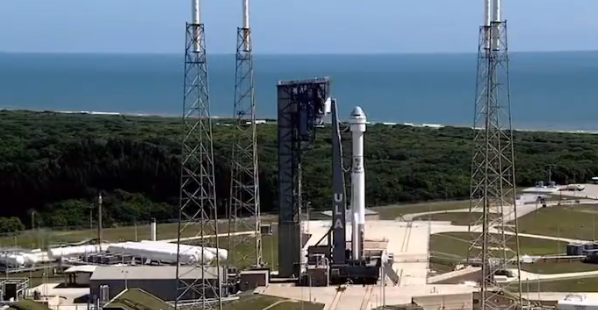Boeing’s successful launch of the Starliner to the International Space Station on June 5 signifies a major shift in America’s space capabilities and its geopolitical competition with Russia and China. After thirteen years of reliance on Russia for access to the ISS, the U.S. has reestablished its independent pathway to space, signaling preparations for potential conflicts beyond Earth.
Footage of the Boeing Starliner carrying two NASA astronauts lifting off aboard a ULA Atlas 5 rocket pic.twitter.com/eLlBYW2t3L
— Sarwat Nasir (@SarwatNasir) June 5, 2024
Arthur Herman, director of the quantum alliance initiative at the Hudson Institute, emphasizes that future space warfare will likely involve unmanned systems. Boeing’s Starliner could play a crucial role by deploying unmanned assets into space, enabling maneuvers that could be pivotal if space becomes a battleground. Bryan Clark, director of the center for defense concepts and technology at the Hudson Institute, highlights that this advancement is not only significant for national security but also for potential lunar missions.
However, the progress of American adversaries in space is cause for concern. China’s Chang’e 6 probe recently returned from the far side of the moon with lunar rocks, and a Chinese space plane released an unidentified object that might be a subsatellite deployment. General Stephen Whiting, commander of the United States Space Command, points out that China has significantly increased its on-orbit intelligence and reconnaissance satellites since 2018, creating a “kill web” aimed at American military capabilities.
Russia, too, has been active in space, launching a satellite with the potential to spy on American assets and possibly weaponize its capabilities. Despite Russia’s declining space prowess, Clayton Swope, deputy director of the aerospace security project at the Center for Strategic and International Studies, warns that Russia’s lower stakes could make them more likely to attack American satellites. While the use of nuclear weapons in space is unlikely, Swope suggests the need to prevent Russia from gaining such capabilities by collaborating with partners like India.
NASA Astronaut Barry “Butch” Wilmore prior to the launch of Boeing Starliner, commenting on the mission and overall American exceptionalism:
“Each of you display what this nation’s forefathers envisioned: a people committed to God, family, and country. A people who use their… pic.twitter.com/x5L5lXSSAH
— Jordan Schachtel @ dossier.today (@JordanSchachtel) June 5, 2024
Iran is another player advancing its space technology, launching satellites that could enhance its ballistic missile program. Bryan Clark warns of space warfare tactics like electromagnetic pulses that could disable American satellites, emphasizing the need for enhanced space situational awareness and communication capabilities.
The establishment of the Space Force in 2019, America’s sixth branch of the Armed Forces, reflects the growing recognition of space as a critical domain for national and international security. The Space Force aims to improve space-based communications and situational awareness, particularly for geosynchronous satellites. Bryan Clark advocates for leveraging commercial providers to enhance these capabilities.
Today the launch of the Boeing Starliner was the first time since Mercury Atlas 9, on May 15 1963, an Atlas rocket was used for a crewed mission.
It was also the first time since Apollo 7, on October 11 1968, that a crewed mission was launched from Cape Canaveral. pic.twitter.com/TwKWsSZ1KL— Lennert van den Boom-Stoop (@Lennert_vd_Boom) June 5, 2024
Arthur Herman underscores the need for the Space Force to develop a standalone strategy and draw on commercial resources to address threats in space. Despite a slight reduction in its budget for fiscal year 2025, the Space Force’s success may hinge on commercial achievements, such as Boeing’s Starliner mission.
The U.S. maintains a unique advantage in its ability to innovate, according to Clayton Swope. However, this lead is not guaranteed, and the U.S. must continue to advance its space capabilities to stay ahead in this new arena of geopolitical competition.
Key Points:
i. Boeing’s Milestone: The successful launch and docking of Boeing’s manned Starliner at the International Space Station ends America’s 13-year dependence on Russia for access to the ISS.
ii. Geopolitical Tensions: The Starliner’s success marks a shift from cooperative space travel with Russia to preparing for potential space-based conflicts involving Russia and China.
iii. Unmanned Systems and National Security: Experts highlight the importance of unmanned systems for future space warfare and the role Starliner could play in enhancing American space maneuvering capabilities.
iv. Chinese and Russian Advancements: China’s rapid progress in space technology, including the Chang’e 6 probe and increased satellite capabilities, along with Russia’s deployment of potentially weaponized satellites, underscores the competitive and hostile space environment.
v. Space Force and Commercial Collaboration: The U.S. Space Force aims to enhance space-based communications and situational awareness, leveraging commercial successes like Starliner, despite a reduced budget for 2025.
Lap Fu Ip – Reprinted with permission of Whatfinger News



